A New Modeling Framework for Multi-Scale Simulation of Hydraulic Fracturing and Production from Unconventional Reservoirs
Abstract
1. Introduction
2. High-Performance Modeling Framework with GEOS and TOUGH+
2.1. Geomechanical Simulator GEOS
2.2. Multi-Phase Multi-Component Simulator TOUGH+
2.3. Coupling Scheme between GEOS and TOUGH+
- (1)
- A meshing tool builds the TOUGH+ mesh representing the reservoir model and the selected well stage. The mesh incorporates major fractures explicitly and fills the space between fractures with continuum elements. Mesh design includes deciding which fractures will be explicitly represented in the TOUGH+ model (major stimulated and natural fractures) and which fractures can be represented by appropriate continuum representations (secondary and minor fractures) using a double porosity, dual permeability or a MINC matrix-fracture model.
- (2)
- For all stimulated major fractures, calculate the “propped aperture” with Equation (1), where and are the aperture and the proppant volume fraction as simulated with GEOS, is the maximum volume fraction in this hydraulic fracture, is an empirical parameter that characterizes the closure aperture of the hydraulic fractures [34]. Use the cubic law (or other appropriate relationships) to calculate the permeability of all explicit fractures.
- (3)
- For each fracture explicitly represented in the mesh, apply local grid refinement along the y-axis perpendicular to the fracture. The mesh elements are refined near the hydraulic fractures with a minimum y-resolution () larger than the maximum propped aperture, . The refinement extends into the adjacent matrix to allow the resolution of steep gradients during production simulation.
- (4)
- Map the GEOS-derived propped aperture field of each explicit fracture to the corresponding fracture grid cells in the TOUGH+ mesh. This results in one layer of “fracture cells” sandwiched by the adjacent “matrix cells”. If GEOS and TOUGH+ use different mesh resolutions in x, z directions, 2D spatial interpolation is used to match the grid resolutions.
- (5)
- Reduce of the fracture cells to exactly match the propped aperture. Increase for adjacent matrix cells to fill up the volumes lost. We include the option of setting a lower bound for to remedy situations where an extremely small aperture may cause numerical convergence issues during flow simulation. We use in the present workflow. An example of the TOUGH+ mesh before and after coupling the GEOS aperture is shown in Figure 2.
- (6)
- (7)
- Property changes due to micro-scale processes with fractures and at the fracture-matrix interfaces are incorporated based on the imaging, testing, and modeling work described in Section 5. Specifically, impacts of proppant mechanics are accounted for with constitutive relationships, built on micro-scale imaging and meso-scale testing, that adjust the permeabilities of propped fractures as a function of simulated stress changes during production (Section 5.1). Similar adjustments are made to account for chemical reactions within fractures and at the fracture-matrix interfaces (fracture face) (Section 5.2).
- (8)
- We expect that this physics-based modeling framework for microscopic to reservoir-scale simulation of hydraulic fracturing and production should be capable of addressing the full range of reservoir response from propagation of fractures to hydrocarbon production, in a fully predictive sense. However, if the simulated production is not consistent with production measurements, the entire workflow starting with the GEOS stimulation model may be repeated.
3. Hydraulic Fracturing Field Test Site in the Permian Basin (USA)
4. Reservoir-Scale Simulations of HFTS with GEOS and TOUGH+
4.1. Hydraulic Fracturing Modeling Based on HFTS Observations
4.2. Preliminary Producton Simulations with TOUGH+
- (1)
- GEOS-full: Uses the full coupling scheme described in Section 2.3, where the heterogeneous propped aperture (Figure 8) is fully mapped onto its TOUGH+ meshed representation.
- (2)
- GEOS-mean: Uses the shape of the hydraulic fractures modeled by GEOS, but the mean propped aperture is assigned to all fracture cells, which results in a homogeneous fracture aperture, but a fracture shape/extent determined by GEOS simulation.
- (3)
- Rectangular: Uses a rectangular fracture, and the mean aperture for the hydraulic fractures. This method has been previously used in other HF simulation studies where the details of fracture geometry were unknown [42]. The fracture area of the Rectangular case is chosen to match the area predicted by GEOS (with <0.2% difference), to ensure the correct fracture volume.
- (1)
- The initial water saturation in the altered layer at the fracture-shale interface affects the early-time production behavior
- (2)
- Gas exsolution in the fracture and in the near-fracture zone, and early-time gas production is sensitive to fracture mean aperture. This is important as gas saturation in the near-fracture zone has significant effects on the mobility of the oil phase.
- (3)
- The oil and gas production rates, derived from stage-by-stage simulation, are overpredicted at longer timescales compared to HFTS field data, suggesting interference between wells.
5. Micro-Scale Experiments and Simulations
5.1. Micro- to Mesoscale Experiments on Proppant Mechanics
5.1.1. Micro-Scale In Situ X-Ray Imaging of Proppant Mechanics
5.1.2. Meso-Scale Testing of Proppant Mechanics
5.2. Impact of Micro-Scale Reactions on Permeability
5.2.1. Geochemical Transport Experiments
5.2.2. Reactive Transport Modeling
6. Discussion and Conclusions
- Observations from the HFTS suggest a need for fundamental corrections to popular conceptual models of stimulation and production in unconventional reservoirs. Specifically, we have demonstrated that the presence of fracture swarms may help explain the reduced hydraulic fracture lengths observed via microseismic signals. Our proposed approach for addressing this phenomenon can readily be incorporated into existing simulators and reduce the need for ad hoc parametric fitting.
- We have developed an automated procedure for TOUGH+ reservoir simulations based on GEOS fracture outputs. Preliminary production models for the HFTS suggest the importance of fracture/well interference and highlight other relevant sensitivities, such as the effect of near-fracture shale alterations (“skin” effect).
- We conducted a series of experiments on micro- to meso-scale proppant behavior in unreacted and reacted HFTS core. Experimental analysis provides relationships between normalized conductivity in the propped fracture and the differential stress on the sample, which can be directly used as input to reservoir-scale simulations.
- Fracture flow-through experiments were conducted to measure reactions effects in realistic fractures. Furthermore, we established procedures and pore-scale modeling analysis to investigate micro-scale shale alteration due to interactions with fracturing fluids. We are currently working on upscaling methods for micro-scale fracture and shale reactions that can be used in the field scale models for stimulation and production.
Author Contributions
Funding
Institutional Review Board Statement
Informed Consent Statement
Data Availability Statement
Acknowledgments
Conflicts of Interest
References
- McClure, M.; Picone, M.; Fowler, G.; Ratcliff, D.; Kang, C.; Medam, S.; Frantz, J. Nuances and frequently asked questions in field-scale hydraulic fracture modeling. In Proceedings of the SPE Hydraulic Fracturing Technology Conference and Exhibition, The Woodlands, TX, USA, 4–6 February 2020. SPE-199726-MS. [Google Scholar] [CrossRef]
- Kempka, T.; Class, H.; Görke, U.-J.; Norden, B.; Kolditz, O.; Kühn, M.; Walter, L.; Wang, W.; Zehner, B. A Dynamic Flow Simulation Code Intercomparison based on the Revised Static Model of the Ketzin Pilot Site. Energy Procedia 2013, 40, 418–427. [Google Scholar] [CrossRef]
- CMG. STARS User Guide; Computer Modeling Group LTD: Calgary, AB, Canada, 2018. [Google Scholar]
- Settgast, R.R.; Fu, P.; Walsh, S.D.; White, J.A.; Annavarapu, C.; Ryerson, F.J. A fully coupled method for massively parallel simulation of hydraulically driven fractures in 3-dimensions. Int. J. Numer. Anal. Methods Géoméch. 2016, 41, 627–653. [Google Scholar] [CrossRef]
- Moridis, G.J.; Pruess, P. User manual of the TOUGH+ v1.5 core code: A general purpose simulator of non-isothermal flow and transport through porous and fractured media. In Lawrence Berkeley National Laboratory Report LBNL-6869E; Lawrence Berkeley National Laboratory: Berkeley, CA, USA, 2014. [Google Scholar]
- Voltolini, M.; Ajo-Franklin, J. Evolution of propped fractures in shales: The microscale controlling factors as revealed by in situ X-Ray microtomography. J. Pet. Sci. Eng. 2020, 188, 106861. [Google Scholar] [CrossRef]
- Hakala, J.A.; Crandall, D.; Moore, J.; Phan, T.T.; Sharma, S.; Lopano, C.L. Laboratory-scale studies on chemical reactions between fracturing fluid and shale core from the Marcellus Shale Energy and Environmental Laboratory (MSEEL) site. In Proceedings of the Unconventional Resources Technology Conference, Austin, TX, USA, 24–26 July 2017. [Google Scholar]
- Li, Q.; Jew, A.D.; Kohli, A.; Maher, K.; Brown, J.G.E.; Bargar, J. Thicknesses of Chemically Altered Zones in Shale Matrices Resulting from Interactions with Hydraulic Fracturing Fluid. Energy Fuels 2019, 33, 6878–6889. [Google Scholar] [CrossRef]
- Tournassat, C.; Steefel, C.I. Modeling diffusion processes in the presence of a diffuse layer at charged mineral surfaces: A benchmark exercise. Comput. Geosci. 2019, 1–18. [Google Scholar] [CrossRef]
- Steefel, C.I.; Tournassat, C. A model for discrete fracture-clay rock interaction incorporating electrostatic effects on transport. Comput. Geosci. 2021, 25, 395–410. [Google Scholar] [CrossRef]
- Adachi, J.; Siebrits, E.; Peirce, A.; Desroches, J. Computer simulation of hydraulic fractures. Int. J. Rock Mech. Min. Sci. 2007, 44, 739–757. [Google Scholar] [CrossRef]
- Lecampion, B.; Bunger, A.; Zhang, X. Numerical methods for hydraulic fracture propagation: A review of recent trends. J. Nat. Gas Sci. Eng. 2018, 49, 66–83. [Google Scholar] [CrossRef]
- Voltolini, M.; Kwon, T.-H.; Ajo-Franklin, J. Visualization and prediction of supercritical CO2 distribution in sandstones during drainage: An in situ synchrotron X-ray micro-computed tomography study. Int. J. Greenh. Gas Control. 2017, 66, 230–245. [Google Scholar] [CrossRef]
- Vankeuren, A.N.P.; Hakala, J.A.; Jarvis, K.; Moore, J.E. Mineral Reactions in Shale Gas Reservoirs: Barite Scale Formation from Reusing Produced Water As Hydraulic Fracturing Fluid. Environ. Sci. Technol. 2017, 51, 9391–9402. [Google Scholar] [CrossRef]
- Moore, J.; Hakala, A.; Lopano, C.; Xiong, W.; Phan, T.; Paukert Vankeuren, A.; Sharma, S.; Pilewski, J.; Jarvis, K.; Brown, S.; et al. Bench-top experiment evaluating simulated hydraulic fracturing fluid interactions with Marcellus Shale core. In Proceedings of the Unconventional Resources Technology Conference, Houston, TX, USA, 23–25 July 2018; p. 2901634. [Google Scholar]
- Marcon, V.; Joseph, C.; Carter, K.E.; Hedges, S.W.; Lopano, C.L.; Guthrie, G.D.; Hakala, J.A. Experimental insights into geochemical changes in hydraulically fractured Marcellus Shale. Appl. Geochem. 2017, 76, 36–50. [Google Scholar] [CrossRef]
- Harrison, A.L.; Jew, A.D.; Dustin, M.K.; Thomas, D.L.; Joe-Wong, C.; Bargar, J.R.; Johnson, N.; Brown, G.E.; Maher, K. Element release and reaction-induced porosity alteration during shale-hydraulic fracturing fluid interactions. Appl. Geochem. 2017, 82, 47–62. [Google Scholar] [CrossRef]
- Jew, A.D.; Dustin, M.K.; Harrison, A.L.; Joe-Wong, C.; Thomas, D.L.; Maher, K.; Brown, G.E.; Bargar, J. Impact of Organics and Carbonates on the Oxidation and Precipitation of Iron during Hydraulic Fracturing of Shale. Energy Fuels 2017, 31, 3643–3658. [Google Scholar] [CrossRef]
- Jew, A.D.; Harrison, A.L.; Dustin, M.K.; Joe-Wong, C.M.; Thomas, D.L.; Maher, K.; Brown, G.E., Jr.; Cercone, D.; Bargar, J.R. Mineralogical changes that control pore-scale shale-gas properties. In Proceedings of the Unconventional Resources Technology Conference, Austin, TX, USA, 24–26 July 2017. URTeC: 2708858. [Google Scholar]
- Li, Q.; Jew, A.D.; Kiss, A.M.; Kohli, A.; Alalli, A.; Kovscek, A.R.; Zoback, M.D.; Cercone, D.; Maher, K.; Brown, G.E., Jr.; et al. Imaging pyrite oxidation and barite precipitation in gas and oil shales. In Proceedings of the Unconventional Resources Technology Conference, Houston, TX, USA, 23–25 July 2018. [Google Scholar]
- Jew, A.D.; Li, Q.; Cercone, D.; Maher, K.; Brown, G.E., Jr.; Bargar, J.R. Barium sources in hydraulic fracturing systems and chemical controls on its release into solution. In Proceedings of the Unconventional Resources Technology Conference, Houston, TX, USA, 23–25 July 2018. URTeC: 2899671. [Google Scholar]
- Jew, A.D.; Bargar, J.R.; Brownlow, J.; Laughlan, M. Strontium behavior in Midland Basin unconventional reservoirs: The importance of base fluids. In Proceedings of the Unconventional Resources Technology Conference, Austin, TX, USA, 20–22 July 2020. URTeC: 3016. [Google Scholar]
- Alalli, A.; Li, Q.; Jew, A.; Kohli, A.; Bargar, J.; Zoback, M.; Kovscek, A. Effects of hydraulic fracturing fluid chemistry on shale matrix permeability. In Proceedings of the Unconventional Resources Technology Conference, Houston, TX, USA, 23–25 July 2018. URTeC: 2881314. [Google Scholar]
- Ciezobka, J.; Courtier, J.; Wicker, J. Hydraulic Fracturing Test Site (HFTS)—Project overview and summary of results. In Proceedings of the Unconventional Resources Technology Conference, Austin, TX, USA, 23–25 July 2018. [Google Scholar]
- Weijermars, R.; Nandlal, K.; Tugan, M.F.; Dusterhoft, R.; Stegent, N. Wolfcamp Hydraulic Fracture Test Site drained rock volume and recovery factors visualized by scaled complex analysis method (CAM): Emulating multiple data sources (production rates, water cut, pressure gages, flow regime changes, sand b-sigmolds). In Proceedings of the Unconventional Resources Technology Conference, Austin, TX, USA, 20–22 July 2020. [Google Scholar]
- Salahshoor, S.; Maity, D.; Ciezobka, J. Stage-level data integration to evaluate the fracturing behavior of horizontal wells at the Hydraulic Fracturing Test Site (HFTS): An insight into the production performance. In Proceedings of the Unconventional Resources Technology Conference, Austin, TX, USA, 20–22 July 2020. [Google Scholar]
- Sherman, C.S.; Mellors, R.; Morris, J.P.; Ryerson, F.J. Geomechanical modeling of distributed fiber-optic sensor measurements. Interpretation 2019, 7, SA21–SA27. [Google Scholar] [CrossRef]
- Sherman, C.S.; Morris, J.P.; Fu, P.; Settgast, R.R. Recovering the microseismic response from a geomechanical simulation. Geophys. 2019, 84, KS133–KS142. [Google Scholar] [CrossRef]
- Iyer, J.; Walsh, S.D.; Hao, Y.; Carroll, S. Assessment of two-phase flow on the chemical alteration and sealing of leakage pathways in cemented wellbores. Int. J. Greenh. Gas Control. 2018, 69, 72–80. [Google Scholar] [CrossRef]
- Hao, Y.; Settgast, R.R.; Tompson, A.F.B.; Fu, P.; Morris, J.P.; Ryerson, F.J. The effect of fracture-matrix interactions on multiphase flow in fractured reservoirs—Development of a discrete fracture model. In Proceedings of the XXI International Conference on Computational Meth-ods in Water Resources, CMWR 2016, Toronto, ON, Canada, 20–24 June 2016. [Google Scholar]
- Hao, Y.; Settgast, R.R.; Tompson, A.F.B.; Fu, P.; Morris, J.P.; Ryerson, F.J. Discrete fracture modeling of multiphase flow and hydro-carbon production in fractured shale or low permeability reservoirs. In Proceedings of the American Geophysical Union Fall Meeting, San Francisco, CA, USA, 12–16 December 2016. [Google Scholar]
- Hao, Y.; Settgast, R.R.; Tompson, A.F.B.; Ryerson, F.J. Numerical evaluation of multiphase flow processes and their effects on hy-drocarbon production in hydraulically fractured reservoirs. In Proceedings of the 9th International Conference on Porous Media & Annual Meeting, Rotterdam, The Netherlands, 8–11 May 2017. [Google Scholar]
- Zhang, K.; Moridis, G.J. A Domain decomposition approach for large-scale simulations of coupled processes in hydrate-bearing geologic media. In Proceedings of the 6th International Conference on Gas Hydrates, Vancouver, BC, Canada, 6–10 July 2008. [Google Scholar]
- Huang, J.; Morris, J.P.; Fu, P.; Settgast, R.R.; Sherman, C.S.; Ryerson, F.J. Hydraulic-Fracture-Height Growth Under the Combined Influence of Stress Barriers and Natural Fractures. SPE J. 2019, 24, 302–318. [Google Scholar] [CrossRef]
- Kim, J.; Moridis, G.J. Gas Flow Tightly Coupled to Elastoplastic Geomechanics for Tight and Shale Gas Reservoirs: Material Failure and Enhanced Permeability. SPE Am. Unconv. Resour. Conf. 2012, 19, 1100–1125. [Google Scholar] [CrossRef]
- Kim, J.; Um, E.S.; Moridis, G. Integrated simulation of vertical fracture propagation induced by water injection and its borehole electromagnetic responses in shale gas systems. J. Pet. Sci. Eng. 2018, 165, 13–27. [Google Scholar] [CrossRef]
- Courtier, J.; Chandler, K.; Gray, D.; Martin, S.; Thomas, R.; Wicker, J.; Petroleum, L.; Ciezobka, J. Best practices in designing and executing a comprehensive Hydraulic Fracturing Test Site in the Permian Basin. In Proceedings of the Unconventional Resources Technology Conference, Austin, TX, USA, 24–26 July 2017. [Google Scholar]
- Stegent, N.; Candler, C. Downhole microseismic mapping of more than 400 fracturing stages on a multiwell pad at the Hydraulic Fracturing Test Site (HFTS): Discussion of operational challenges and analytic results. In Proceedings of the Unconventional Resources Technology Conference, Houston, TX, USA, 23–25 July 2018. URTeC: 2902311. [Google Scholar]
- Raterman, K.T.; Farell, H.E.; Mora, O.S.; Janssen, A.L.; Gomez, G.A.; Busetti, S.; McEwen, J.; Davidson, M.; Rutherford, R.; Reid, G.J.; et al. Sampling a stimulated rock volume: An Eagle Ford Example. In Proceedings of the Unconventional Resources Technology Conference, Austin, TX, USA, 20–22 July 2020. URTeC: 2670034. [Google Scholar]
- Gale, J.F.W.; Elliott, S.J.; Laubach, S.E. Hydraulic fractures in core from stimulated reservoirs: Core fracture description of HFTS slant core. In Proceedings of the Unconventional Resources Technology Conference, Midland Basin, TX, USA, 23–25 July 2018. URTeC: 2902624. [Google Scholar]
- Fu, W.; Morris, J.P.; Fu, P.; Huang, J.; Sherman, C.S.; Settgast, R.R.; Wu, H.; Ryerson, F.J. Developing upscaling approach for swarming hydraulic fractures observed at Hydraulic Fracturing Test Site through multiscale simulations. In Proceedings of the SPE Hydraulic Fracturing Technology Conference and Exhibition, The Woodlands, TX, USA, 4–6 February 2020. SPE-199689-MS. [Google Scholar]
- Olorode, O.M.; Freeman, C.M.; Moridis, G.; Blasingame, T. High-Resolution Numerical Modeling of Complex and Irregular Fracture Patterns in Shale-Gas Reservoirs and Tight Gas Reservoirs. SPE Reserv. Eval. Eng. 2013, 16, 443–455. [Google Scholar] [CrossRef]
- Nakagawa, S.; Borglin, S.E. Laboratory In-Situ Visualization of long-term fracture closure and proppant embedment in brittle and ductile shale samples. In Proceedings of the 53rd US Rock Mechanics/Geomechanics Symposium, New York, NY, USA, 23–26 June 2019. ARMA 19–1996. [Google Scholar]
- Xiong, W.; Gill, M.; Moore, J.; Crandall, D.; Hakala, J.A.; Lopano, C. Influence of reactive flow conditions on barite scaling in Marcellus Shale during stimulation and shut-in period of hydraulic fracturing. Energy Fuels 2020, 34, 13625–13635. [Google Scholar] [CrossRef]
- Noël, V.; Spielman-Sun, E.; Druhan, J.L.; Fan, W.; Jew, A.D.; Kovscek, A.R.; Brown, G.E., Jr.; Bargar, J.R. Synchrotron X-ray imaging of element transport resulting from unconventional stimulation. In Proceedings of the Unconventional Resources Technology Conference, Austin, TX, USA, 20–22 July 2020. URTeC: 3295. [Google Scholar]
- Steefel, C.I.; Appelo, C.A.J.; Arora, B.; Jacques, D.; Kalbacher, T.; Kolditz, K.; Lagneau, V.; Lichtner, P.C.; Mayer, K.U.; Meeussen, J.C.L.; et al. Reactive transport codes for subsurface environmental simulation. Comput. Geosci. 2015, 19, 445–478. [Google Scholar] [CrossRef]
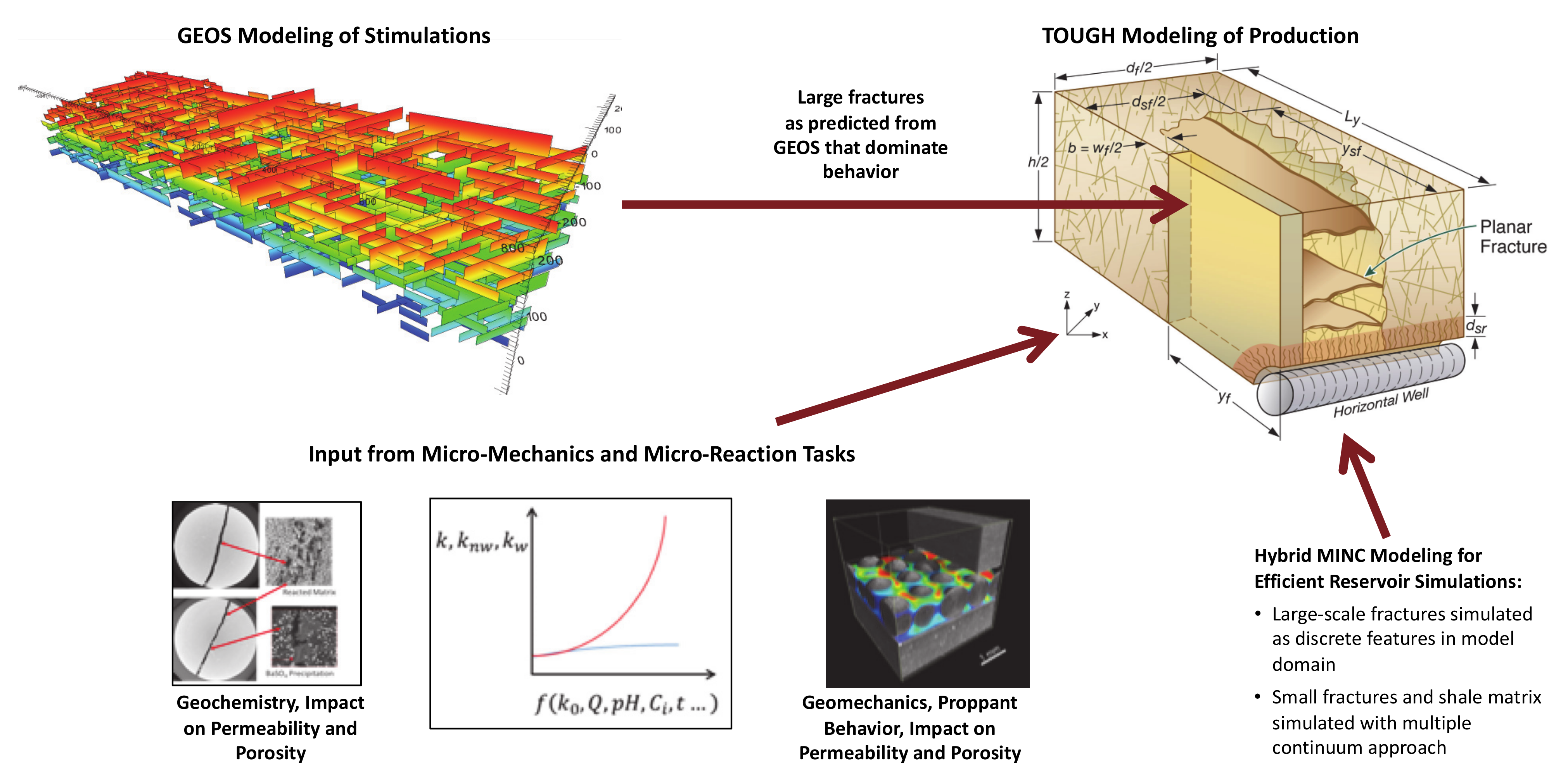
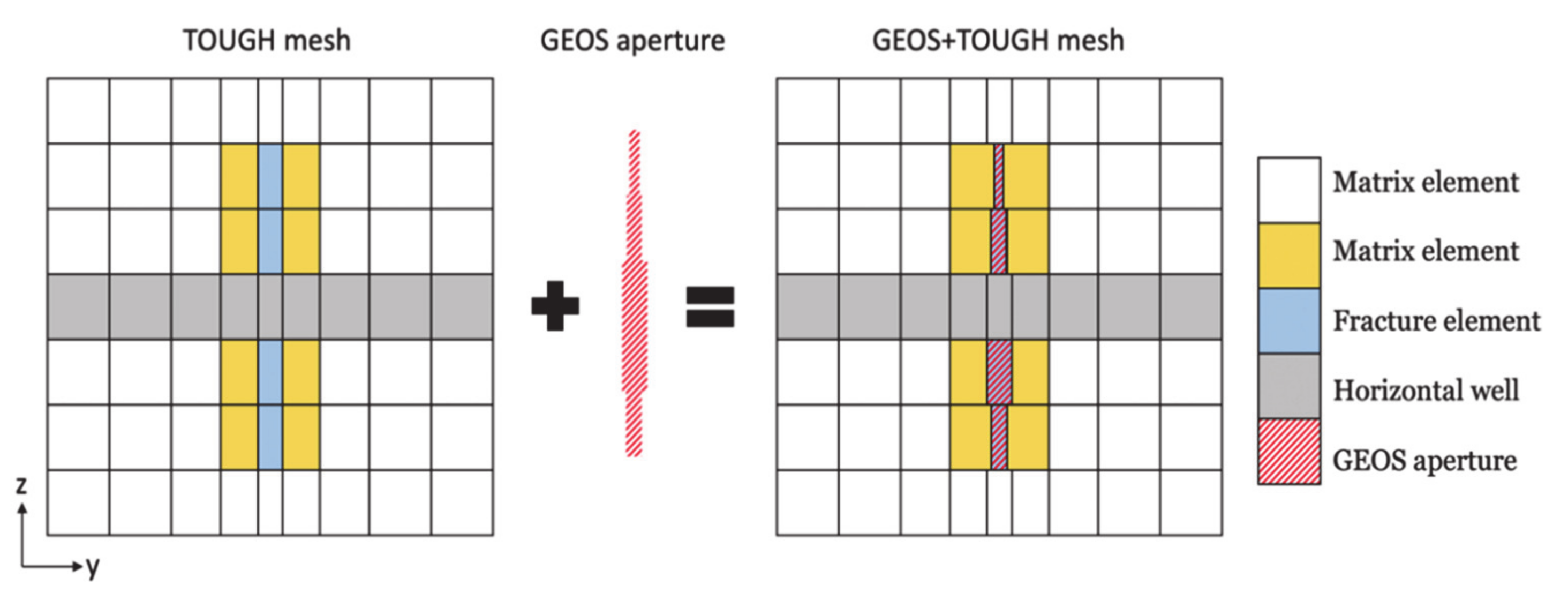
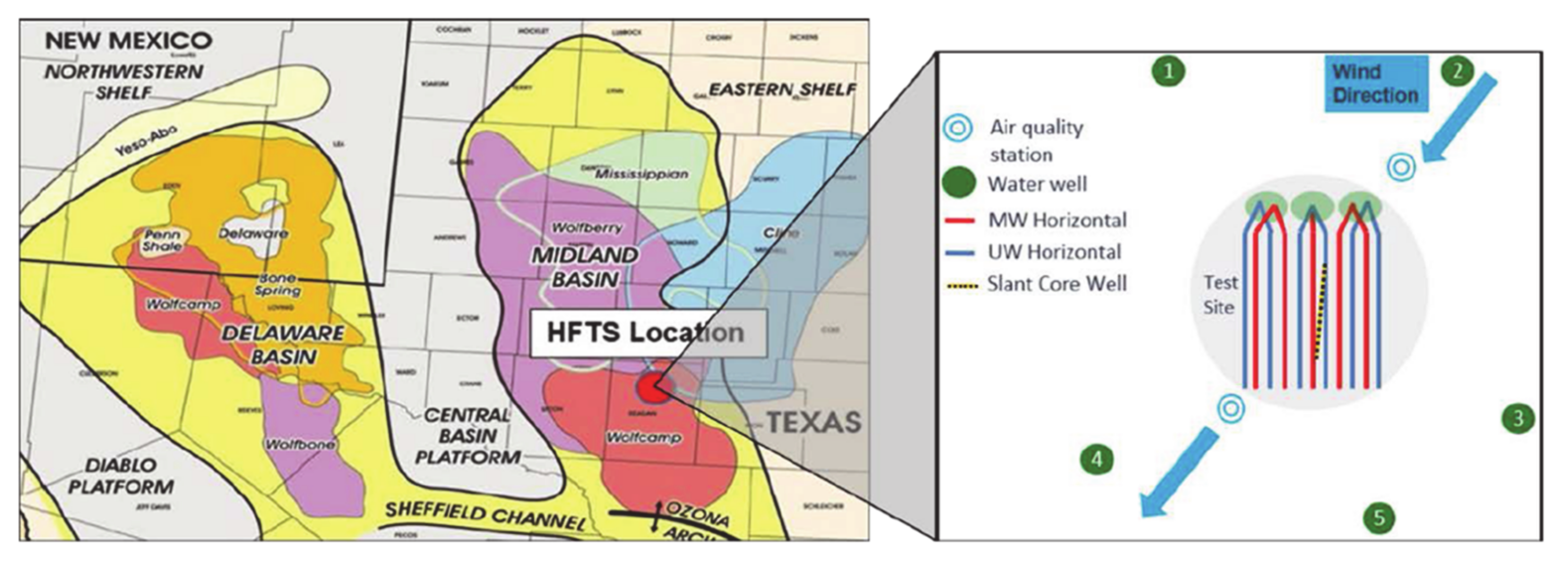
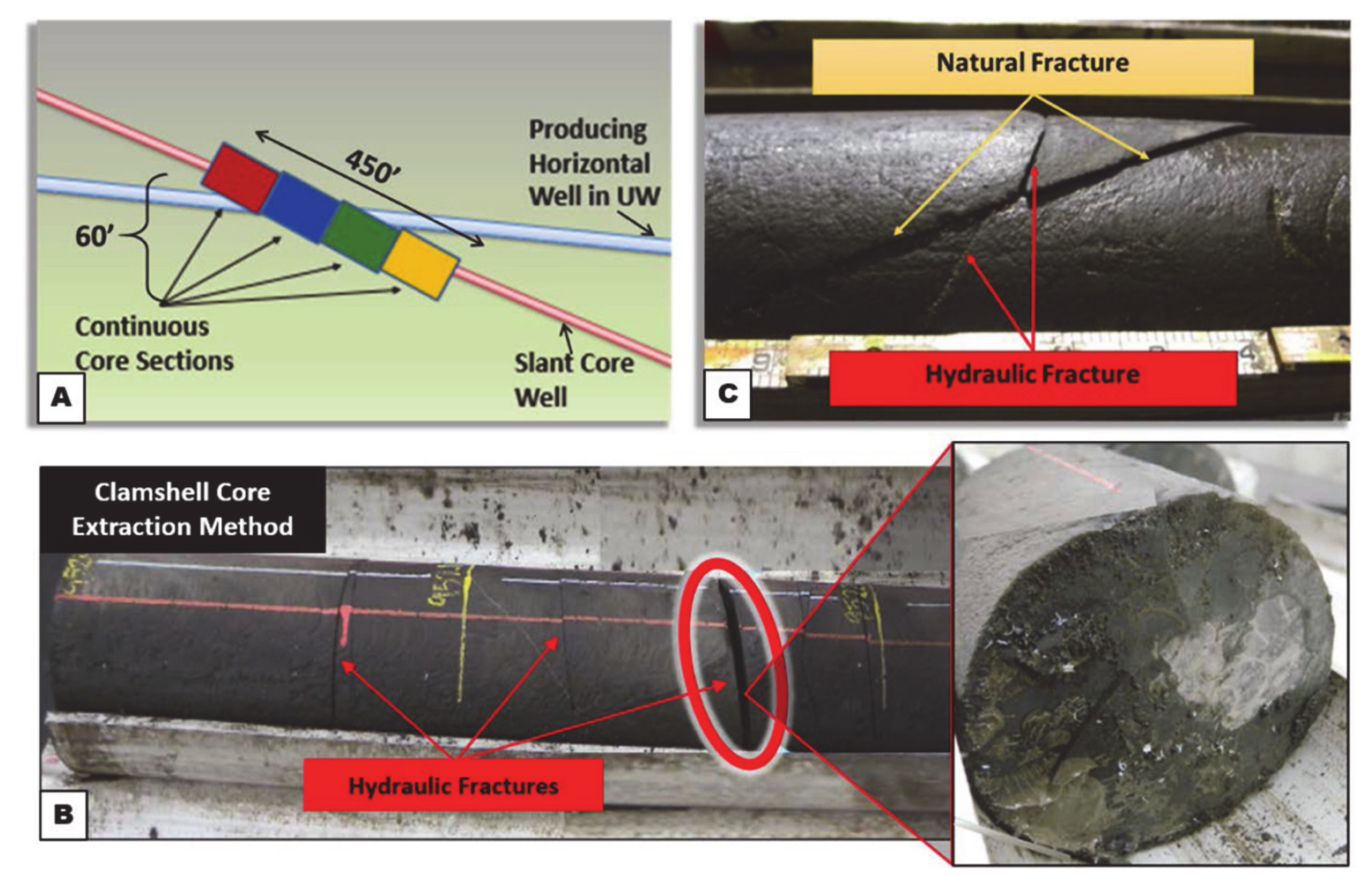
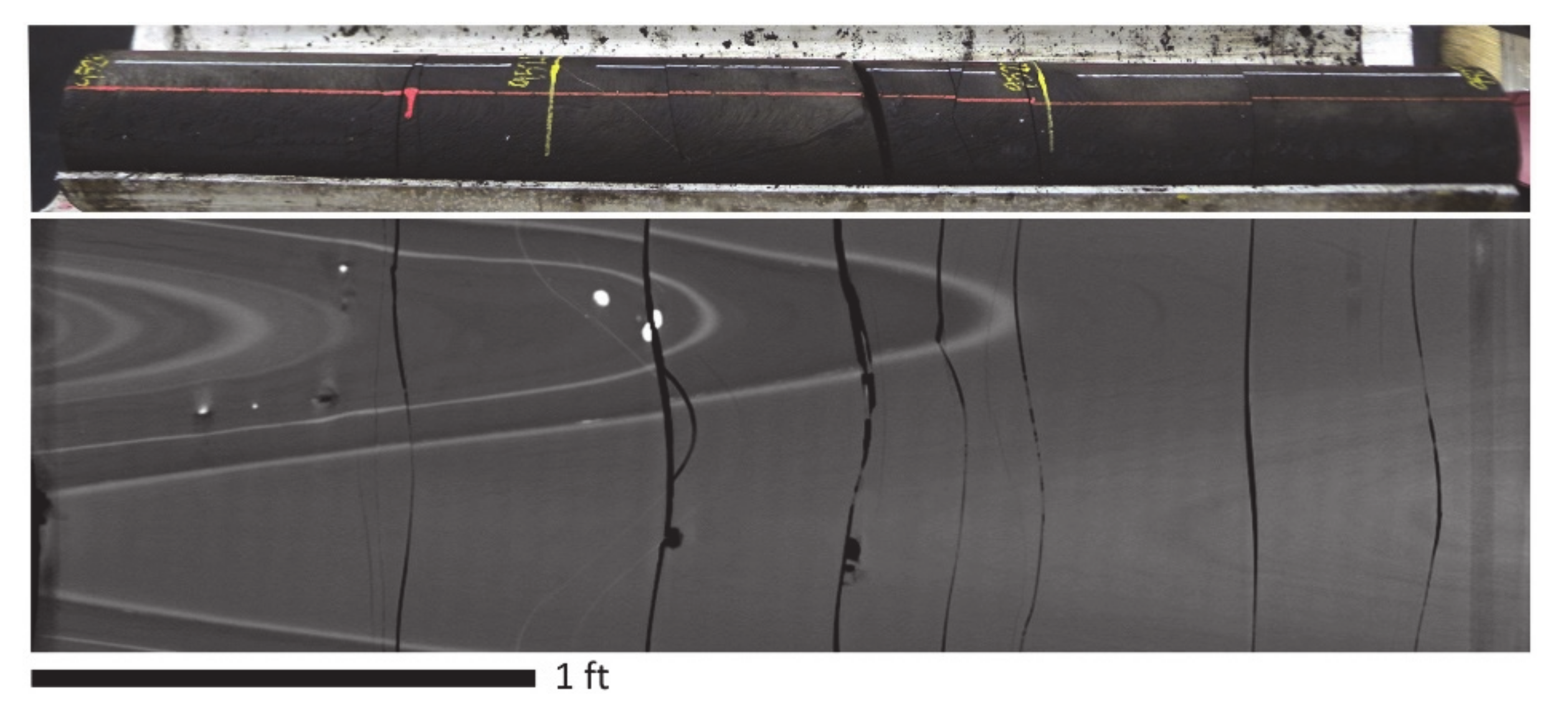
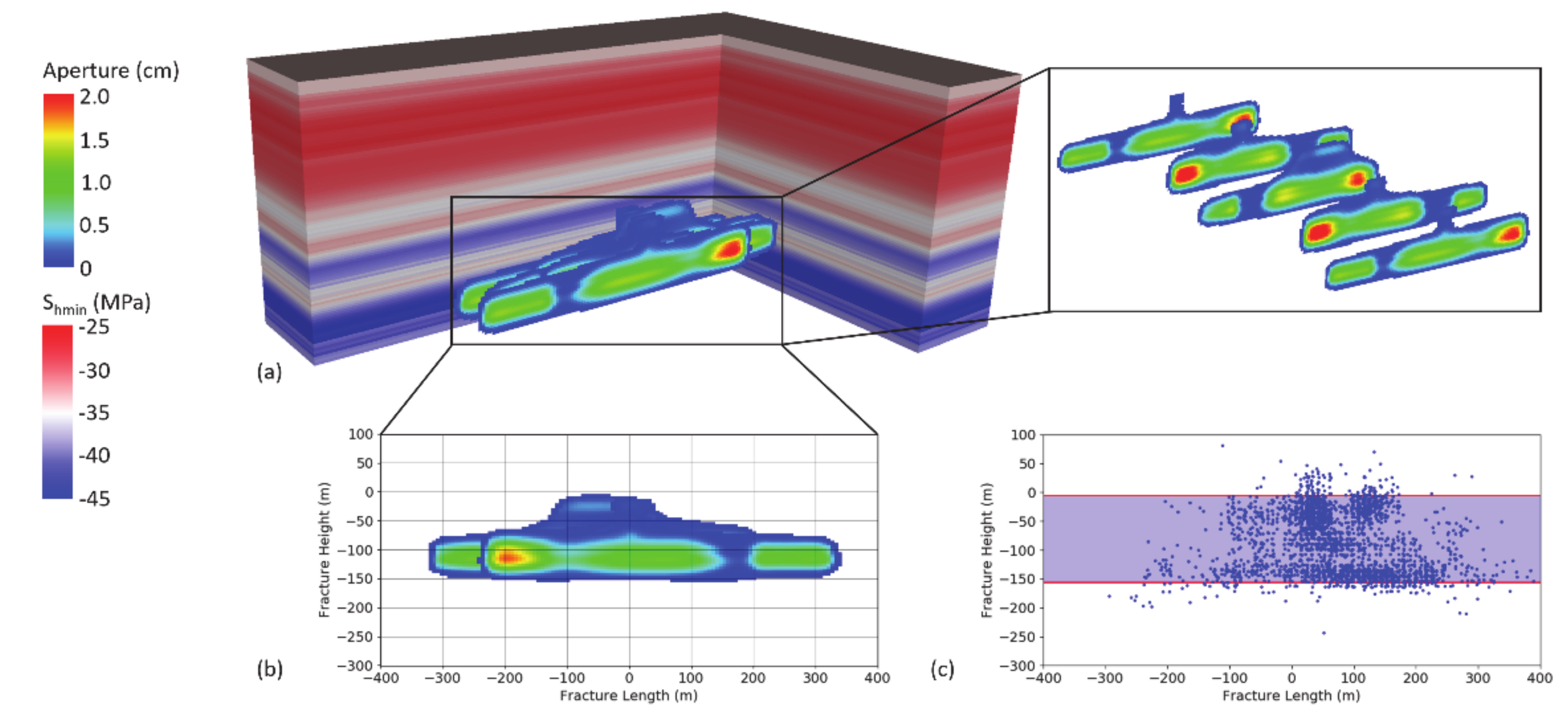
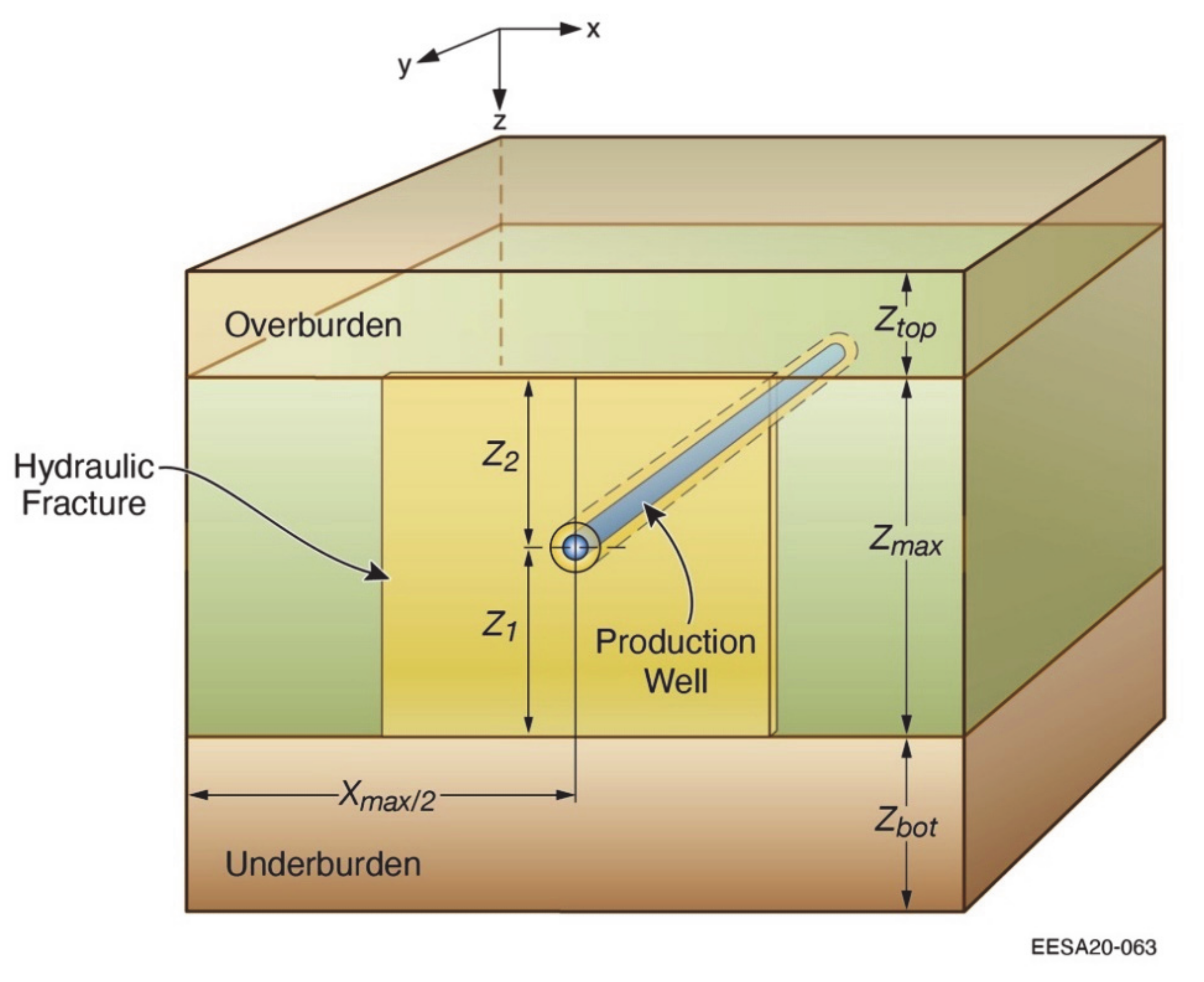

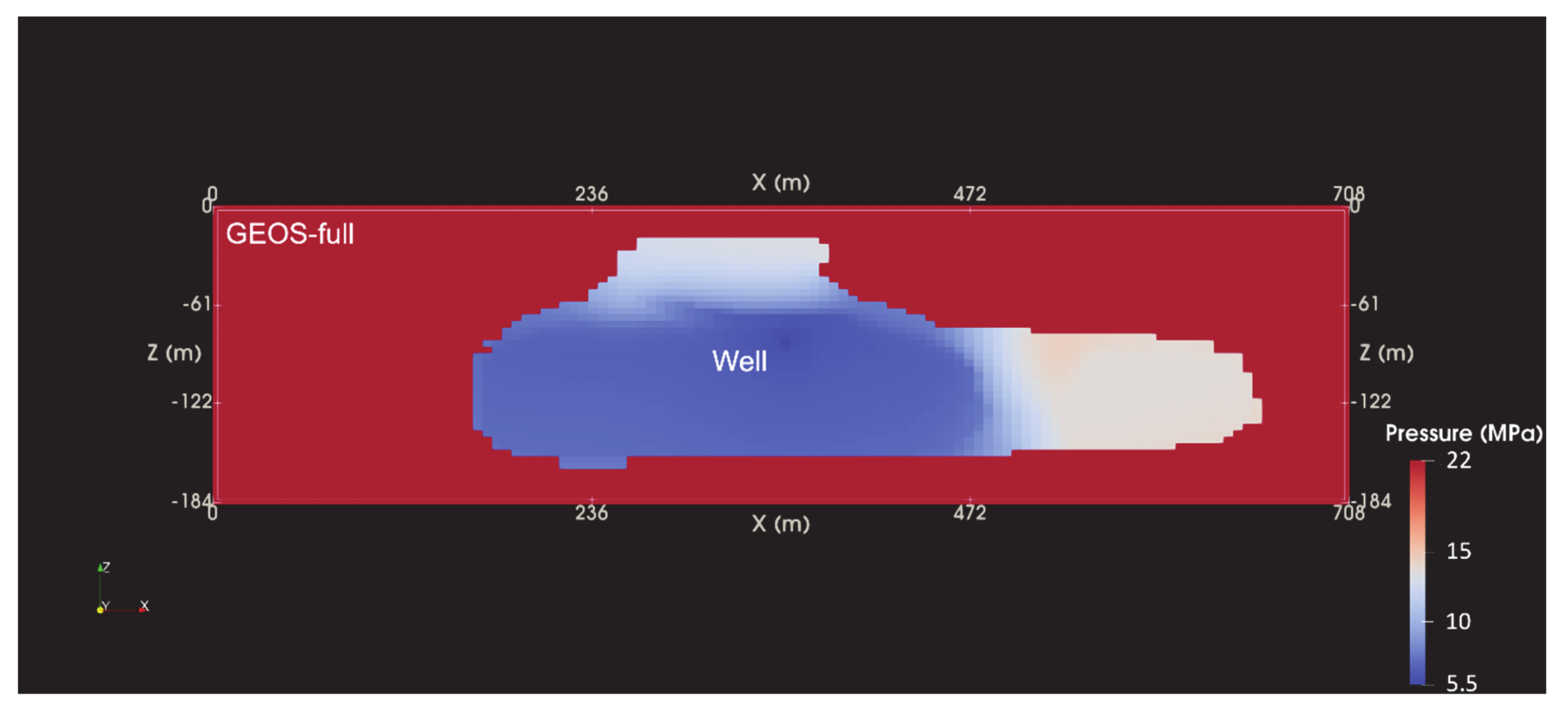
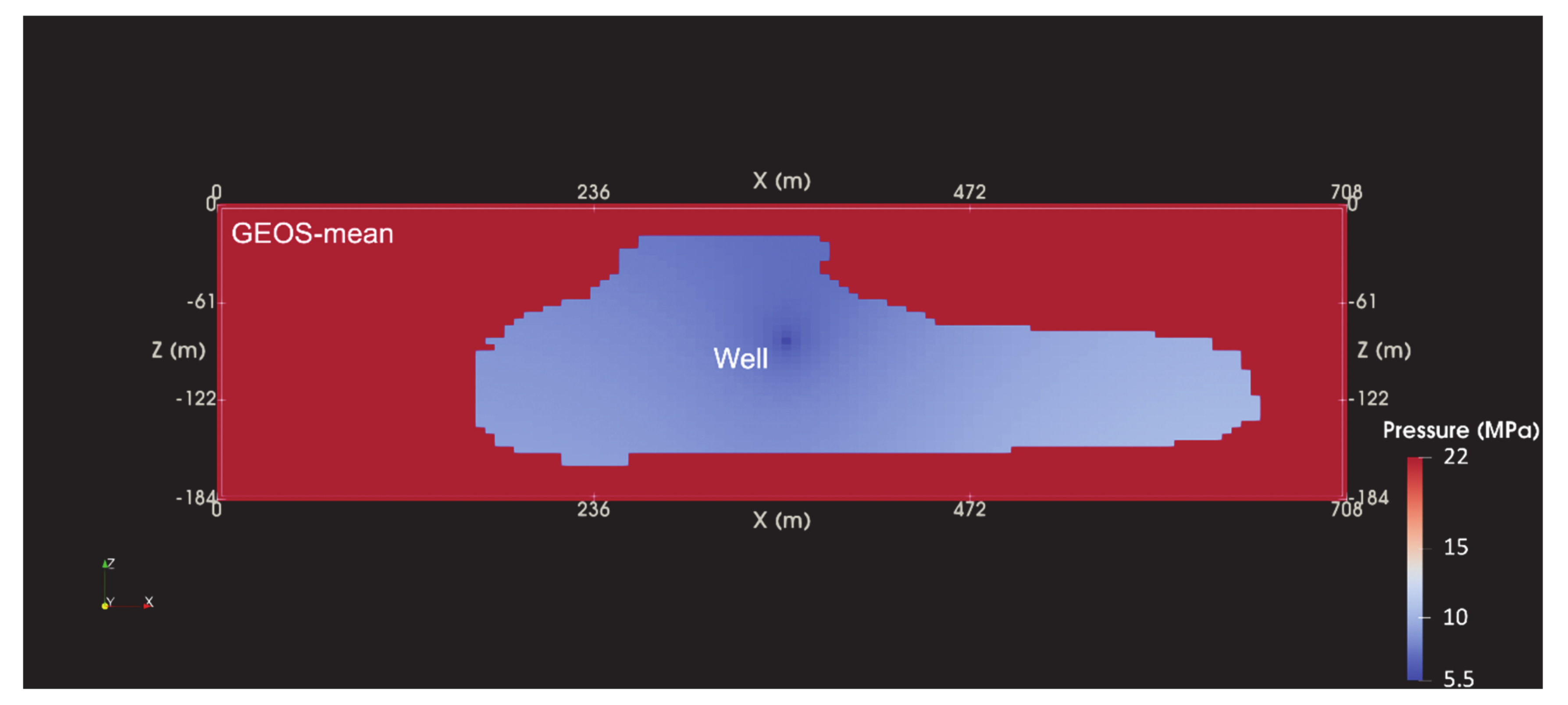

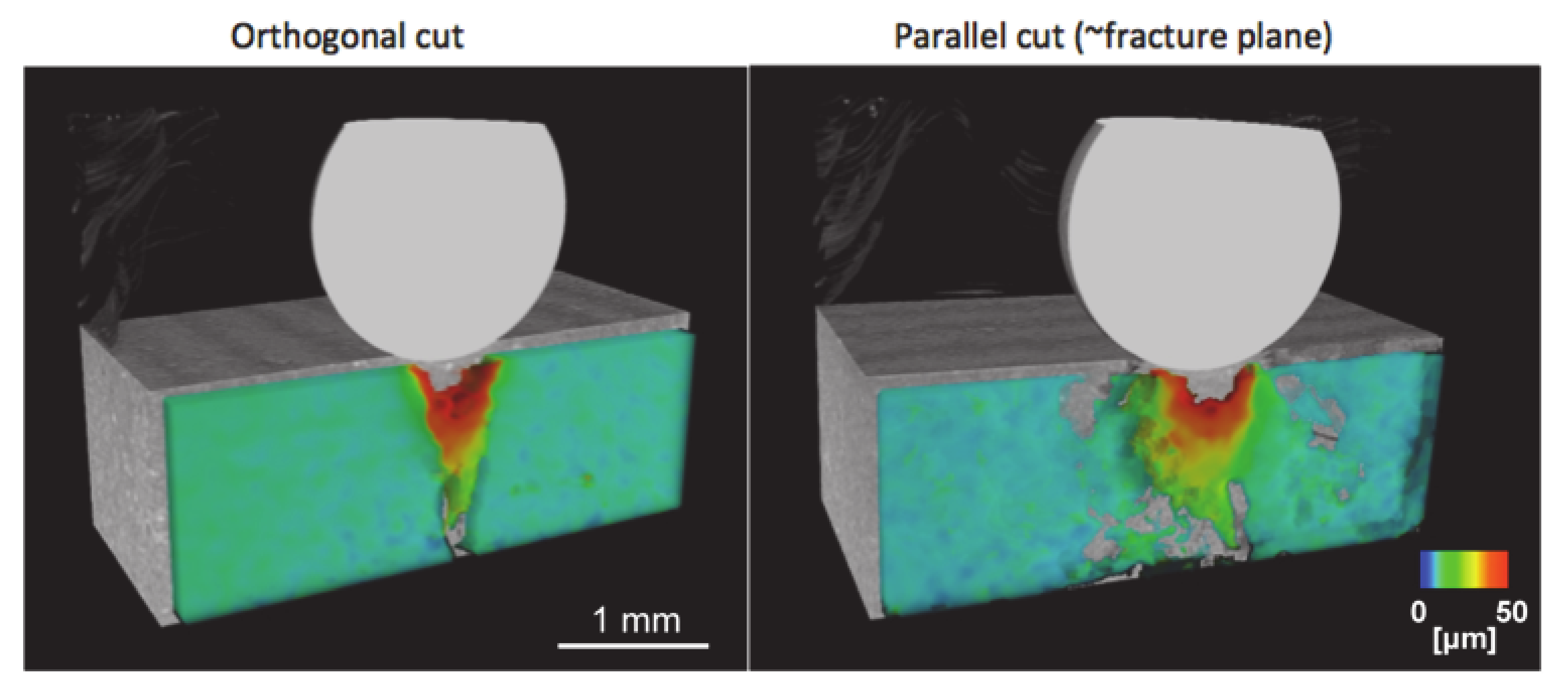


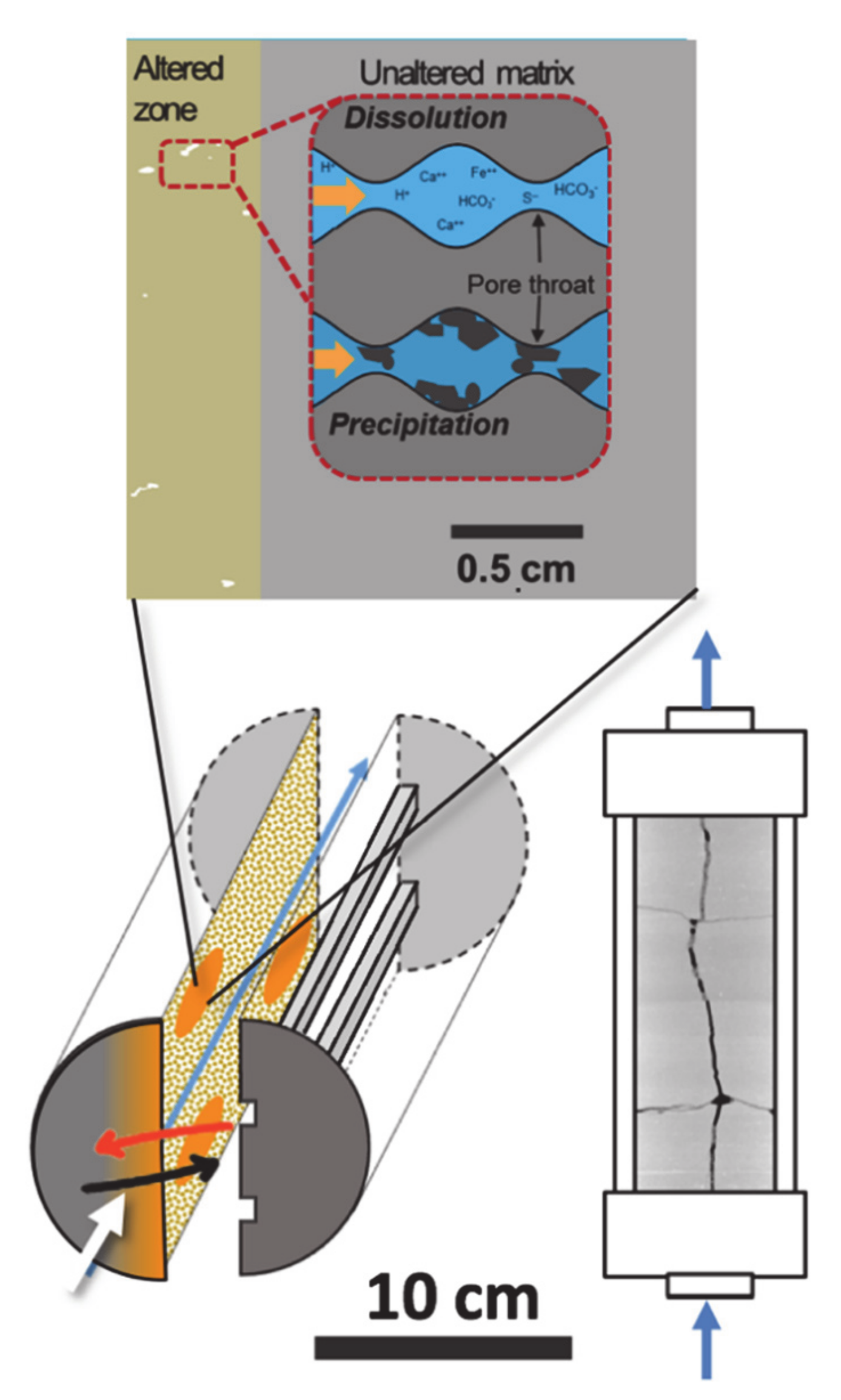


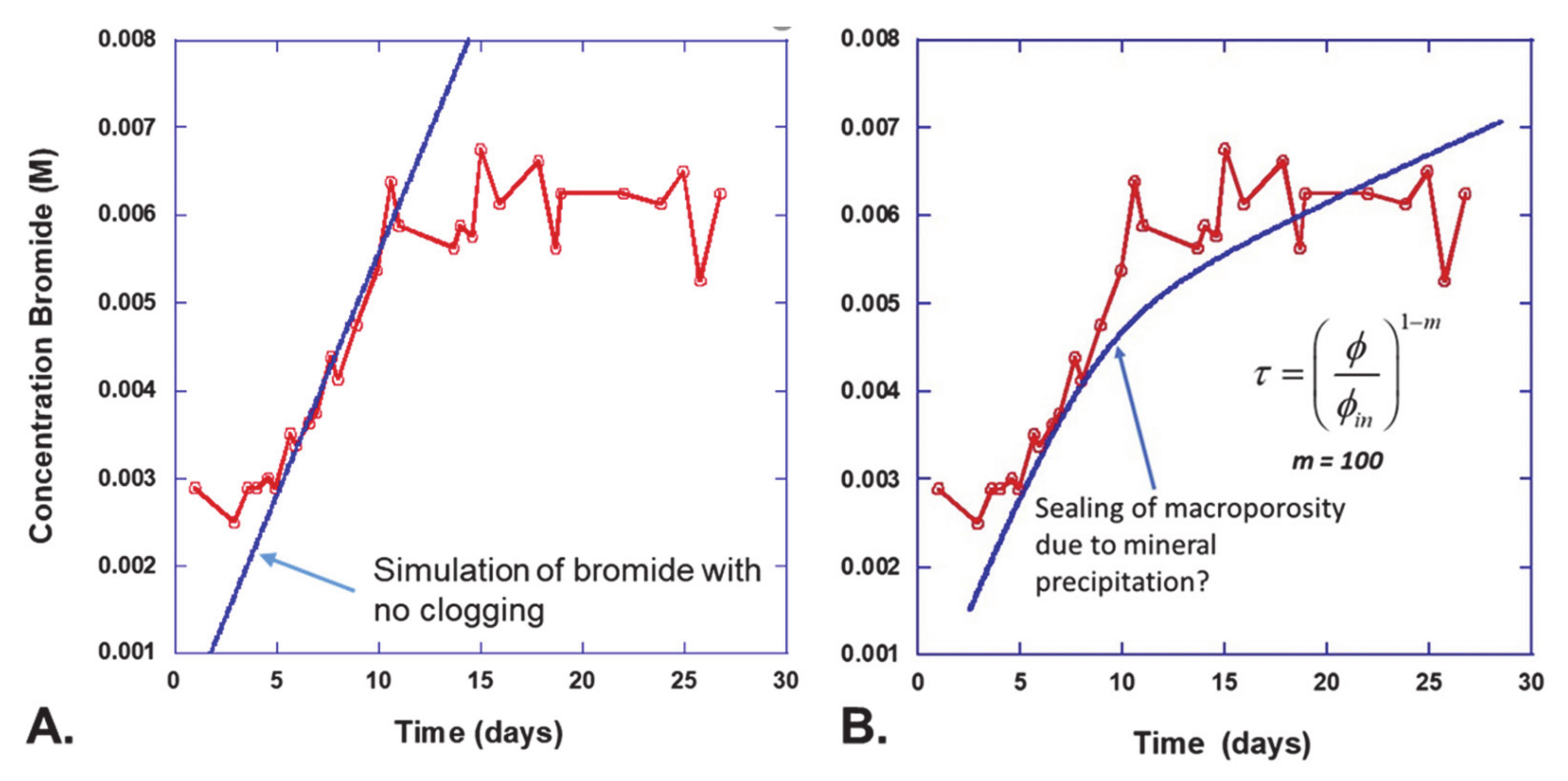

| Parameter | Value |
|---|---|
| Domain dimension (x, y, z) [m] | |
| Grid resolution (x, y, z) [m] | |
| Total fracture area (Rectangular) [m2] | |
| Total fracture area (GEOS) [m2] | |
| Matrix permeability [nD, 10−21 m2] | 100.0 |
| Matrix porosity [-] | 0.07 |
| Fracture porosity [-] | 0.95 |
| Bottomhole pressure [MPa] | 5.5 |
| Bottomhole temperature [°C] | 65.0 |
| Initial reservoir pressure [MPa] | 21.5 |
| Initial reservoir temperature [°C] | 65.0 |
| Initial reservoir oil saturation [-] | 0.55 |
| Initial reservoir gas-oil ratio [SCF/STB] | 600 |
Publisher’s Note: MDPI stays neutral with regard to jurisdictional claims in published maps and institutional affiliations. |
© 2021 by the authors. Licensee MDPI, Basel, Switzerland. This article is an open access article distributed under the terms and conditions of the Creative Commons Attribution (CC BY) license (http://creativecommons.org/licenses/by/4.0/).
Share and Cite
Birkholzer, J.T.; Morris, J.; Bargar, J.R.; Brondolo, F.; Cihan, A.; Crandall, D.; Deng, H.; Fan, W.; Fu, W.; Fu, P.; et al. A New Modeling Framework for Multi-Scale Simulation of Hydraulic Fracturing and Production from Unconventional Reservoirs. Energies 2021, 14, 641. https://doi.org/10.3390/en14030641
Birkholzer JT, Morris J, Bargar JR, Brondolo F, Cihan A, Crandall D, Deng H, Fan W, Fu W, Fu P, et al. A New Modeling Framework for Multi-Scale Simulation of Hydraulic Fracturing and Production from Unconventional Reservoirs. Energies. 2021; 14(3):641. https://doi.org/10.3390/en14030641
Chicago/Turabian StyleBirkholzer, J. T., J. Morris, J. R. Bargar, F. Brondolo, A. Cihan, D. Crandall, H. Deng, W. Fan, W. Fu, P. Fu, and et al. 2021. "A New Modeling Framework for Multi-Scale Simulation of Hydraulic Fracturing and Production from Unconventional Reservoirs" Energies 14, no. 3: 641. https://doi.org/10.3390/en14030641
APA StyleBirkholzer, J. T., Morris, J., Bargar, J. R., Brondolo, F., Cihan, A., Crandall, D., Deng, H., Fan, W., Fu, W., Fu, P., Hakala, A., Hao, Y., Huang, J., Jew, A. D., Kneafsey, T., Li, Z., Lopano, C., Moore, J., Moridis, G., ... Ciezobka, J. (2021). A New Modeling Framework for Multi-Scale Simulation of Hydraulic Fracturing and Production from Unconventional Reservoirs. Energies, 14(3), 641. https://doi.org/10.3390/en14030641







